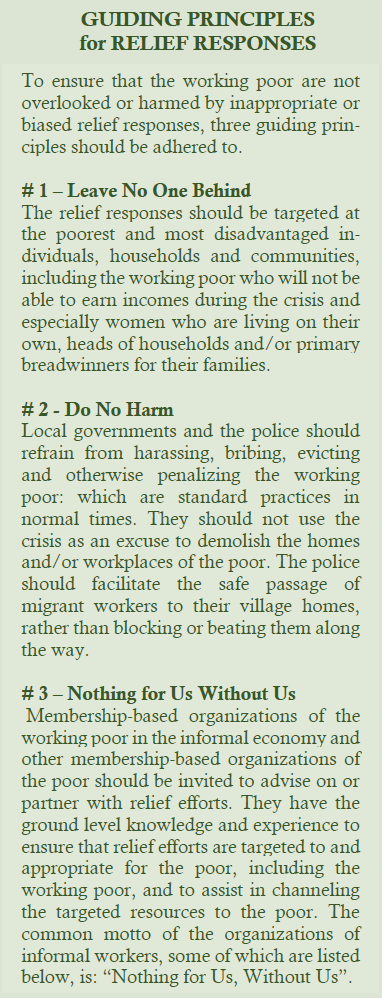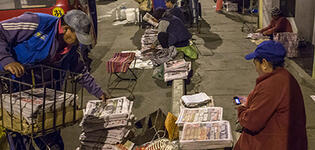Blog
To die from hunger or the virus
An all too real dilemma for the poor in India (and elsewhere)
On March 24, in a speech to the nation, Narendra Modi, Prime Minister of India, announced a 21-day lockdown. With only four hours’ notice, 1.3 billion people were expected to stay at home and not venture out for three weeks. All buses, trains and domestic air flights were suspended. But the authorities had not planned for, much less prepared for, how to handle an abrupt lockdown in such a vast, complex and unequal country.
Panic and chaos ensued. Across the country, the affluent began hoarding food, medicines and other supplies while the poor worried about their livelihoods and the homeless wondered where they might shelter. A mass migration began: hundreds of thousands of migrant workers started to flee cities and towns for their village homes, becoming the most visible human face of a humanitarian crisis. Images flooded the airways: migrant workers standing in congested queues hoping to find a space in (or on) the last trains or buses; migrant workers beginning the long homeward march on foot. Along the way, migrants could not easily find food, drink or a place to rest as everything was closed. Some were sprayed with disinfectants. As a final cruel blow, many migrants were turned back at state borders that had been sealed. It is impossible to fathom the anguish migrant workers felt with no place to go, no food, no solace, only hostile police to confront.
But the plight of the migrant workers is only the tip of a far larger humanitarian crisis unfolding among the working poor in India’s informal economy. Estimates based on the 2017-18 labor force survey of India indicate that there are over 415 million informal workers in India, representing 90 per cent of the country’s total workforce; and nearly 28 million rural-to-urban migrant workers, representing 7 per cent of the country’s informal workforce. The rural informal workforce includes small farmers, landless laborers, shepherds, fisherfolk, weavers and artisans, forest gatherers, food processors and more. The urban informal workforce includes construction day laborers and tradesmen, domestic workers, manufacturing workers (in factories, workshops or homes), street vendors, transport workers and waste pickers.
Essential actors in the Indian economy
Each group of informal workers produces goods or services that are essential to the functioning of the Indian economy: many of which will remain essential during the pandemic-cum-lockdown. Yet their essential goods and services are not valued or supported.
Consider street vendors, who sell fresh food and vegetables, cooked food, clothing and other essentials of life, especially to the poor but also to the middle class. During the lockdown, wholesale markets, retail stores and small grocery stores that sell essential goods have been allowed to remain open. Yet all street vendor markets have been closed. Consider waste pickers, who collect and recycle waste from households, bins, the streets, garbage depots and dumps. Private garbage collection companies are allowed to operate, but not the waste pickers who have provided essential sanitation and environmental services since long before modern waste management systems were introduced. Consider also the municipal street sweepers and sanitation workers who are expected to continue to work but are not given protective gear. And consider home-based garment makers and weavers, now without orders. They could be contracted to produce masks and medical gowns and weave washcloths and towels for the medical relief effort.
Instead of being recognized for their contributions, the poor in India have largely been left to fend on their own with no regard for their livelihoods. Very little consideration has been given to how the poor will earn incomes and buy essential goods and services, or to what will happen to the food chain because of the lockdown. Farmers are finding it hard to sell their produce as transport is not readily available and city (even village) borders are sealed. Truckloads of vegetables and milk are being dumped outside city limits. Wholesalers or big traders are taking advantage of the crisis to buy low and sell high. And street vendors are not allowed to sell food and other essentials to their customers, mainly from poor households who do not shop at retail stores.
Pandemic-cum-lockdown hitting poor harder
Because the virus spreads to all individuals, households and communities — rich and poor, upper, middle and lower caste — the pandemic-cum-lockdown are thought, by some, to be class- or caste-neutral. But the health response and the lockdown are not neutral; neither are the existing health system and economy structure in India. Most poor cannot practice self-distancing as they live in one-room huts and crowded informal settlements. They cannot wash their hands on a regular basis as they have no running water in their homes and often lack sufficient drinking water. Hand sanitizers are not an option — they are unaffordable and in short supply. To access water, many poor, especially women, stand in long queues to collect water from community taps and wells or wait for the water tanker that comes (not frequently enough) to their settlements or neighborhoods. Even in normal times, compared to the rich and middle-class, the poor have less access and ability to pay for health services and, as result, are more likely to die should they fall ill.
Moreover, most poor cannot work remotely at home and cannot buy essential goods online. They live hand-to-mouth — feeding themselves and their families from their daily earnings. If they are forced to stay at home, they will not be able to earn and have limited savings to draw down. Also, their children cannot study online as few poor households have internet. In any case, most public schools in poor neighborhoods are not equipped for digital teaching.
Indequate relief
On March 23, the Finance Minister of Indian announced a national relief package worth 1.7 trillion Indian rupees (USD 23 billion): that is, 18 dollars for each resident of India. The relief package contains many of the relief measures demanded by organizations of the poor, including cash transfers, insurance coverage and steps to promote food security. But the package is more modest than it would appear to be. To begin with, the benefits are very modest ranging from 500 to 2000 rupees per month (USD 7 to 26) for about 200 million recipients for an initial period of three months. In normal times, the average poor family could barely subsist on these amounts for one or two weeks. Also, the budget is padded with pre-committed expenditures and includes spending down of welfare funds, to which workers have contributed and which do not belong to the central government.
One glaring gap is that the national relief package does not include funds for emergency food distribution or feeding centers that are essential to stave off hunger, most immediately among migrant workers. Fortunately, some states like Kerala and Maharashtra as well as the Delhi Union Territory have opened feeding centers for stranded migrants, the homeless and destitute.
Key measures required
Other key measures demanded by organizations of informal workers and social activists include:
 Emergency Relief
Emergency Relief
- Provide transport and other support to migrant workers to facilitate their safe journey back to their village homes.
- Convert community spaces (schools, colleges, community halls and buildings) into shelters for stranded migrants and the homeless.
- Distribute free rations to the poor for three months.
- Provide cooked food to stranded migrant workers, the homeless and destitute for three months.
- Distribute midday meals to the homes of public-school students and children in public day care centers (anganwadi) for three months.
- Deliver packed food to the elderly and disabled in their homes using community youth volunteers for three months.
Income Replacement
- Provide the equivalent of 25 days of minimum wages per month to all informal workers, rural and urban, until two months after the crisis passes OR provide 15,000 rupees to each poor household until two months after the crisis passes.
- Double existing pension payments to widows, fisherfolk, and other disadvantaged groups until two months after the crisis passes.
- Double existing welfare fund payments to construction workers, bidi workers and other groups of workers who contribute to and/or are covered by national or state welfare funds.
Food Chain Security
- Encourage all farmers to grow food crops in the next season, rather than cash crops.
- Buy the surplus produce of farmers at fair prices and transport the produce to towns and cities.
- Allow street vendors to buy food items at wholesale markets or retail stores and to sell food items in informal settlements and low-income neighborhoods, leaving food at doorsteps Allow them to buy food items and wholesale markets or retail stores and provide bicycle or motorcycle rickshaws to help them transport goods.
Health Services
- Commit 5 per cent of GDP for public spending on health services, including free and universal primary and secondary health care and free hospitalization for the poor.
- Enlist private hospitals, clinics and health care providers in the relief effort and make them follow standard protocols and price controls.
- Prohibit hospitals and clinics from turning away or charging any patient who comes for diagnosis or treatment with symptoms that could be COVID-19.
Public Services
- Essential services, such as the public distribution system, water supply, sanitation and waste management, should be continued with the necessary health precautions and personal protective gear provided for service providers.
- Deploy water tankers daily to informal settlements that do not have water for washing and set up community hand washing facilities.
- Some services could be repurposed during the crisis: e.g. public schools could be used as public health centers, local schoolteachers could provide public health outreach and government childcare centers/attendants could take care of the children of frontline emergency workers.
- Repurpose some services to help with the relief response: e.g. village schools and childcare centers could be used as public health centers and the schoolteachers and childcare attendants could be trained to provide public health outreach (by phone or WhatsApp).
The double tsunami of the pandemic and lockdown in India will continue to have devastating impacts on the health and livelihoods of the poor. The worst is yet to come. But if these measures could be incorporated into the national, state and local relief packages — and if the organizations of the poor could be considered as key partners in the relief effort —there is hope that both the health and economic impacts of the crisis can be mitigated.
Perhaps the pandemic-cum-lockdown represents an opportunity to reflect on the structural inequalities and injustices in India today. The crisis is throwing a spotlight on the living and working conditions of the poor and on the essential goods and services they provide. Some groups of working poor could be deployed as frontline emergency workers – providing these essential goods and services during the crisis, especially to poor households and neighborhoods. The crisis is also throwing light on the structural injustices and inequalities in the existing health system and economic structure. This provides an opportunity to reflect on these injustices and inequalities and begin to address them as India deals with and emerges from this crisis.
The views expressed in this piece are those of the author(s), and do not necessarily reflect the views of the Institute or the United Nations University, nor the programme/project donors.
 Join the network
Join the network










